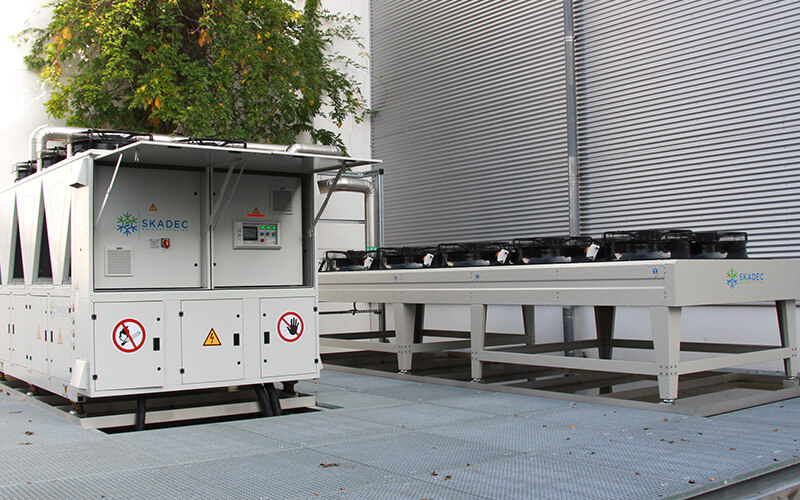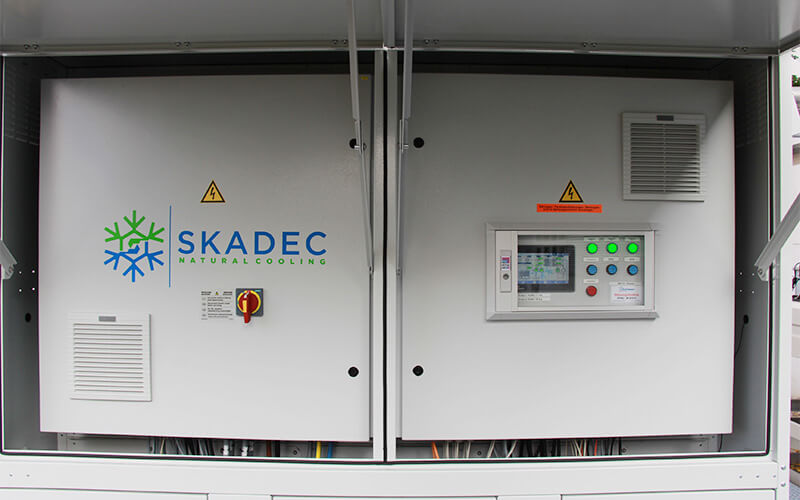Technical article “Natural refrigerants for technology group”
for the trade journal DIE KÄLTE+KLIMATECHNIK
Schott AG replaced its first chiller in Landshut in summer 2019. The company wanted to use the natural refrigerant propane (R290) for the new process cooling system.
For the operator, the natural refrigerant offers a long-term and future-proof alternative to chemical options. As a result of the F-Gas Regulation (EU) No. 517/2014 and the phase-down decided therein, companies are exposed to an incalculable long-term risk for the operation of the system. The gradual reduction in the amount of CO2 equivalent for refrigerants available on the market described in the phase-down, down to 21 per cent in 2030, is already having a significant impact on refrigerant prices. Natural refrigerants are not affected by the F-Gas Regulation. Propane (R290) is characterised by its high energy efficiency, low pressure level and simple system handling during operation. Compared to other HFO and HFC refrigerants, the naturally flammable gas occurs in the atmosphere, so it is not an artificially produced foreign gas for which any environmental damage is not yet foreseeable. Schott AG is an internationally active technology group that is a leader in the fields of speciality glass and glass-ceramics.
LUFTGEKÜHLTER PROPAN KALTWASSERSATZ
Der Propan (R290) Kaltwassersatz verfügt in seiner energieeffizienten Anlagenkonfiguration bei 35 °C Umgebungstemperatur über 320 kW Kälteleistung. Ausgestattet mit zwei getrennten Kältekreisläufen, einer sechsstufigen Leistungsregelung, sechs ECVentilatoren und einer industriellen SPS mit 7“ Touch Display. Die Überhitzungsregelung erfolgt über elektronische Einspritzventile. Jeder Kältekreislauf wird durch zahlreiche Sensoren und einem intelligenten Regelalgorithmus gesteuert, analysiert und überwacht. Beim Einsatz von Propan als Kältemittel wird von den Verdichtern-Herstellern oftmals eine vergleichsweise hohe Gesamtüberhitzung vorgegeben. In der Regel wird diese durch die Verwendung eines Sauggaswärmetauschers erreicht. Jedoch gerade bei niedriger Umgebungstemperatur und verringertem Kältemittelmassenstrom verliert dieser an Leistung, was schnell zu einer zu niedrigen Gesamtüberhitzung und somit zu Verdichterschäden führen kann. Um das zu vermeiden, erfassen Skadec Kaltwassersätze standardmäßig die Verdampfer- und die Gesamtüberhitzung. In Kombination mit der dynamischen Überhitzungsregelung ist so der Verdichter-Schutz garantiert. Als positiver Nebeneffekt ist es so auch möglich, bei hohen Umgebungstemperaturen die Plattenüberhitzung zu reduzieren und somit die Maschine deutlich effizienter zu betreiben.
GLT SOFTWARE INTEGRATED IN THE CHILLER
In addition to the old chiller, part of the hydraulic system was also replaced. The high flow temperature of 10 °C can be fully covered from an ambient temperature of +5 °C by a 295 kW free cooler installed next to the chiller. The use of free cooling at such high system temperatures is a sensible and sustainable decision, which also improves the energy balance of the overall system. The hydraulic system was designed in such a way that both individual operation of the chiller or free cooler and mixed operation (series connection) are possible. This allows part of the required cooling capacity to be covered by free cooling during the transitional period. An innovative control algorithm calculates the temperature spread at which the use of free cooling is actually worthwhile. In the original planning, a separate control cabinet was planned as the higher-level control system for the entire system, consisting of a chiller, free cooler, three-way valve, redundant pump group for the primary circuit with glycol/water mixture and a redundant pump group for the secondary circuit in the building with the medium water.
Thanks to close cooperation between the operator, planner, installer and machine manufacturer, the concept was adapted so that the control and monitoring of all the components mentioned were integrated into the chiller’s PLC. The visualization can be operated in the building on a PC, via remote maintenance or directly on the machine. This makes day-to-day work much easier for service technicians and operating personnel. The modular, expandable programmable logic controller can be operated intuitively by plant engineers. Similar to modern smartphones, no extensive operating instructions are required. All process values and error messages are displayed in plain text in German. Depending on the operating status, the individual actuators and process values are highlighted in color. In the event of a fault, the cause can be pinpointed at a glance. Service managers in the office can connect to the entire system and see the same visualization as the service technician on site in the factory. Changes to settings and programs can be updated via remote maintenance access. The connection to the Internet is made via a network or a mobile phone card. Particularly in the event of faults in the refrigeration process, it is important that the operating behavior can be traced in detail. The powerful data logger, which is integrated as standard and stores all process values (60 to 80) every single second over a period of several years, helps with this. Plant engineers can retrieve and analyze these values remotely before sending a service technician on site.
RISK MANAGEMENT
In the risk assessment prepared by the operator, the risks associated with an outdoor installation with a very low refrigerant charge were considered. Access to the chiller is restricted and only possible for trained personnel. Furthermore, a propane gas sensor is installed inside the machine, which de-energizes the system via two switching stages. The EX-protected system components are supplied with a separate supply line. An integrated EX fan ventilates the housing and ensures that no explosive mixture can form. Any faults that occur are forwarded directly to the higher-level building management system. Optionally, these can also be sent by e-mail.



